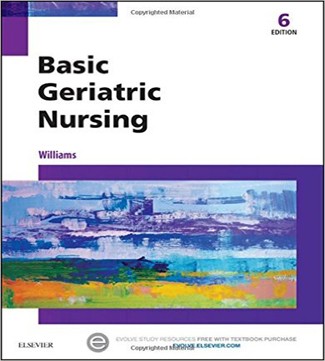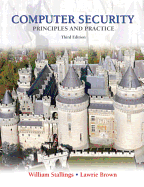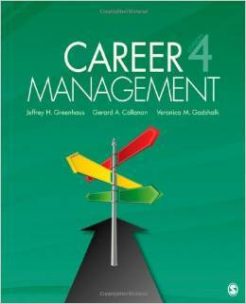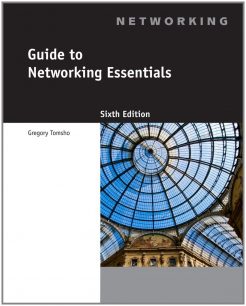Description
ISBN-10: 0323187749
ISBN-13: 9780323187749 978-0323187749
Chapter 03: Physiologic Changes
Test Bank
MULTIPLE CHOICE
1. Why does the nurse modify the environment to keep it warmer for the older adult?
a. A change in the metabolic rate
b. Decreased subcutaneous tissue
c. Changes in the musculoskeletal system
d. A weakened peripheral vascular system
ANS: B
The reduction of subcutaneous tissue as an age-related change causes sensitivity to cold because it is the main insulator of the body.
DIF: Cognitive Level: Application REF: pp. 32-33 OBJ: 1
TOP: Sensitivity to Cold KEY: Nursing Process Step: Implementation
MSC: NCLEX: Physiological Integrity: Physiological Adaptation
2. A 75-year-old male is worried that his wartlike dark macules with distinct borders are melanomas. What would be the most likely cause for the macules?
a. Senile lentigo
b. Cutaneous papillomas
c. Seborrheic keratoses
d. Xerosis
ANS: C
Dark, slightly raised macules are seborrheic keratoses, which may be mistaken for melanomas.
DIF: Cognitive Level: Comprehension REF: p. 32 OBJ: 1
TOP: Seborrheic Keratosis KEY: Nursing Process Step: Implementation
MSC: NCLEX: Physiological Integrity: Physiological Adaptation
3. The nurse is accompanying a group of older adults on a July 4th outing to monitor heat prostration. What factor is related to heat intolerance in the older adult?
a. An increase in melanin
b. A reduction of perspiration
c. A reduction in body temperature
d. Increased capillary fragility
ANS: B
Reduction in perspiration related to reduced sweat gland function results in possible heat intolerance from an inability to cool the body by evaporation.
DIF: Cognitive Level: Analysis REF: p. 33 OBJ: 2
TOP: Heat Intolerance KEY: Nursing Process Step: Assessment
MSC: NCLEX: Physiological Integrity: Physiological Adaptation
4. The nurse cautions the Certified Nursing Assistants (CNAs) to use care when transferring or handling older adults. The nurse understands that the vascular fragility of the older adult can result in which of the following conditions?
a. Altered blood pressure
b. Pressure ulcers
c. Pruritus
d. Senile purpura
ANS: D
Increased capillary fragility results in subcutaneous hemorrhage or senile purpura from careless handling by caregivers.
DIF: Cognitive Level: Comprehension REF: p. 33 OBJ: 7
TOP: Senile Purpura KEY: Nursing Process Step: Planning
MSC: NCLEX: Physiological Integrity: Physiological Adaptation
5. Which symptom would be a characteristic of a stage I pressure ulcer on an older adult’s coccyx?
a. Clear blister
b. Nonblanchable area of erythema
c. Scaly abraded area
d. Painful reddened area
ANS: B
A red nonblanchable area is indicative of a stage I pressure ulcer.
DIF: Cognitive Level: Analysis REF: p. 34 OBJ: 5
TOP: Pressure Ulcers KEY: Nursing Process Step: Assessment
MSC: NCLEX: Physiological Integrity: Physiological Adaptation
6. The Certified Nursing Assistant (CNA) caring for an older adult asks if the yellow, waxy, crusty lesions on the patient’s axilla and groin are contagious. Which response shows the nurse’s understanding for the cause of the lesions?
a. “Yes. It is cellulitis caused by bacteria.”
b. “No. It is seborrheic dermatitis caused by excessive sebum.”
c. “Yes. It is an indication of scabies.”
d. “No. It is the lesion seen with basal cell carcinoma.”
ANS: B
Seborrheic dermatitis is a bothersome skin condition resulting from an excess of sebum.
DIF: Cognitive Level: Application REF: p. 35 OBJ: 5
TOP: Seborrheic Dermatitis KEY: Nursing Process Step: Implementation
MSC: NCLEX: Physiological Integrity: Physiological Adaptation
7. Why would a nurse lead a group of postmenopausal women on a daily 15-minute “walking tour” through the long-term care facility?
a. To improve bone strength
b. To orient them to their surroundings
c. To improve their socialization
d. To increase their appetite
ANS: A
Stress to long bones by weight-bearing and walking will increase bone strength.
DIF: Cognitive Level: Analysis REF: p. 35 OBJ: 7
TOP: Bone Strength KEY: Nursing Process Step: Implementation
MSC: NCLEX: Physiological Integrity: Physiological Adaptation
8. A 70-year-old woman asks, “How in the world can my bones be brittle when I eat all the right foods?” Which response by the nurse would be the most informative?
a. “Calcium loss is expected in the older adult.”
b. “Calcium is continuously withdrawn from bone for nerve and muscle function.”
c. “Smoking and alcohol consumption speed calcium loss from the bones.”
d. “Walking and standing increase calcium loss from the bone.”
ANS: B
Calcium is constantly withdrawn from the bone for nerve and muscle function and clotting needs.
DIF: Cognitive Level: Comprehension REF: p. 35 OBJ: 3
TOP: Calcium Loss KEY: Nursing Process Step: Implementation
MSC: NCLEX: Physiological Integrity: Physiological Adaptation
9. A 70-year-old woman complains, “I weigh exactly the same as I did when I wore a size 10 and now I can barely squeeze into a size 16.” Which statement by the nurse would most correctly explain the size change to the woman?
a. “Metabolism in the older adult creates increased adipose tissue.”
b. “Postmenopausal women gain adipose tissue related to loss of calcium.”
c. “Decrease in muscle mass is replaced with adipose tissue.”
d. “Kyphosis causes a redistribution of weight.”
ANS: C
Decrease in muscle mass is replaced with adipose tissue, which frequently changes the appearance of the body, but not the weight.
DIF: Cognitive Level: Application REF: p. 38 OBJ: 4
TOP: Loss of Muscle Mass KEY: Nursing Process Step: Implementation
MSC: NCLEX: Physiological Integrity: Physiological Adaptation
10. What would be the most helpful response to a 70-year-old postmenopausal woman who asks whether her hormone replacement therapy (HRT) will prevent bone loss?
a. “No. HRT is not helpful after the age of 60.”
b. “Yes. HRT will prevent bone loss but can cause a stroke, heart attack, or breast cancer.”
c. “No. HRT is reliant on some natural estrogen production from the ovaries.”
d. “Yes. HRT is a widely accepted therapy for prevention of bone loss.”
ANS: B
HRT is helpful to prevent bone loss, but the risks of cardiovascular complications and cancer have made the choice of HRT controversial.
DIF: Cognitive Level: Analysis REF: p. 38 OBJ: 4
TOP: Hormone Replacement Therapy KEY: Nursing Process Step: Implementation
MSC: NCLEX: Physiological Integrity: Physiological Adaptation
11. What are Heberden nodes?
a. Yellow longitudinal lines in the nails
b. Thickened discolored fingernails
c. Darkened areas under the fingernail
d. Bony enlargements of distal joints of the fingers
ANS: D
Heberden nodes are bony enlargements of the distal joints of the fingers associated with osteoarthritis.
DIF: Cognitive Level: Knowledge REF: p. 39 OBJ: 5
TOP: Heberden Nodes KEY: Nursing Process Step: N/A
MSC: NCLEX: Physiological Integrity: Physiological Adaptation
12. Which care plan modification would be the most beneficial for a 62-year-old woman who is suffering from a flare in her rheumatoid arthritis?
a. Increase fluid intake
b. Schedule several rest periods to balance activity
c. Reduce salt in the diet
d. Assist with rigorous finger extension exercises
ANS: B
Balancing rest and activity allows the resident to remain relatively flexible. Joints may be splinted to reduce contracture.
DIF: Cognitive Level: Application REF: p. 39 OBJ: 5
TOP: Rheumatoid Arthritis KEY: Nursing Process Step: Planning
MSC: NCLEX: Physiological Integrity: Physiological Adaptation
13. What is the pathophysiology of emphysema?
a. Constriction of the bronchial tree, excessive mucus, and nonproductive cough
b. Calcification of the alveoli and a dry cough
c. Overinflation of the alveoli, making them ineffective for gas exchange
d. Inflammation of the trachea and bronchioles, excessive mucus, and productive cough
ANS: C
Emphysema causes overinflation of the nonelastic alveoli, which disallows gas exchange in the affected alveoli and results in reduced oxygenation.
DIF: Cognitive Level: Comprehension REF: p. 41 OBJ: 5
TOP: Emphysema KEY: Nursing Process Step: Implementation
MSC: NCLEX: Physiological Integrity: Physiological Adaptation
14. What is the pathophysiology of a myocardial infarct?
a. A portion of the myocardium necroses and scars over.
b. The coronary vessels are narrowed during the attack.
c. The ischemic myocardium causes pain during the attack but is able to regenerate.
d. There is damage to the myocardium but no serious alteration of cardiac output.
ANS: A
The myocardium necroses and scars and does not regenerate. The degree of heart damage is related to the amount of necrosis.
DIF: Cognitive Level: Comprehension REF: p. 45 OBJ: 5
TOP: Myocardial Infarct KEY: Nursing Process Step: Implementation
MSC: NCLEX: Physiological Integrity: Physiological Adaptation
15. Which of the following assessments are the cardinal signs and symptoms of congestive heart failure?
a. Dyspnea and edema
b. Myocardial pain and hypotension
c. Ventricular arrhythmias and cyanosis
d. Atrial arrhythmias and polycythemia
ANS: A
Dyspnea and generalized edema are the cardinal signs and symptoms of congestive heart failure.
DIF: Cognitive Level: Application REF: p. 46 OBJ: 5
TOP: Congestive Heart Failure KEY: Nursing Process Step: Assessment
MSC: NCLEX: Physiological Integrity: Physiological Adaptation
16. What is a cause of pernicious anemia?
a. An iron deficiency
b. A deficiency of vitamin B12
c. Low serum potassium level
d. Blood loss
ANS: B
Pernicious anemia results from a deficiency of vitamin B12.
DIF: Cognitive Level: Knowledge REF: p. 49 OBJ: 5
TOP: Pernicious Anemia KEY: Nursing Process Step: Implementation
MSC: NCLEX: Physiological Integrity: Physiological Adaptation
17. What would be an acceptable alteration in the plan of care for a patient with a hiatal hernia who is experiencing gastrointestinal reflux?
a. Encouraging the patient to lie down after meals
b. Drinking two full glasses of liquid after the evening meal
c. Eating smaller, more frequent meals
d. Using caffeine drinks to assist with digestion
ANS: C
Eating smaller and more frequent meals does not enlarge the stomach.
DIF: Cognitive Level: Analysis REF: p. 52 OBJ: 5
TOP: Hiatal Hernia KEY: Nursing Process Step: Planning
MSC: NCLEX: Physiological Integrity: Reduction of Risk







Reviews
There are no reviews yet.